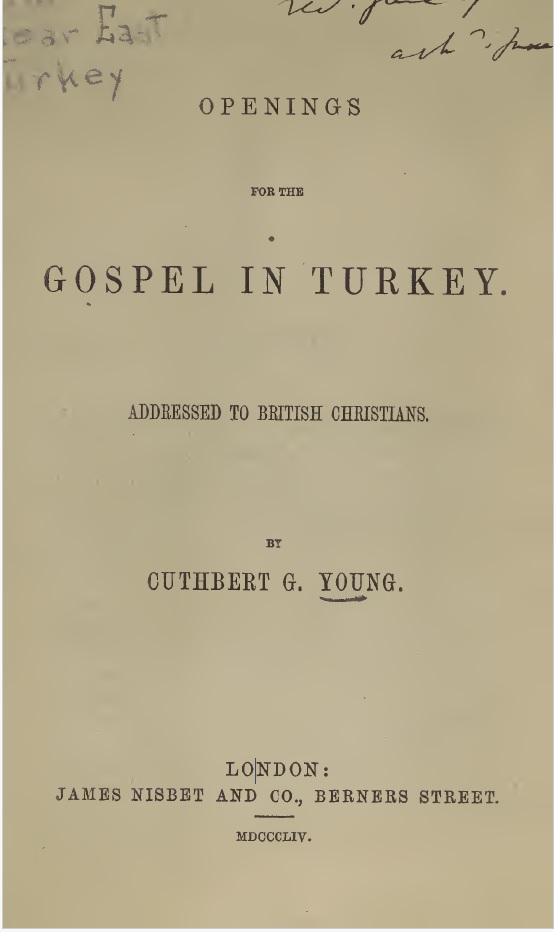Sustaining Missions: Cuthbert G. Young and Transnational Evangelical Collaboration in the Ottoman Empire

In the mid-nineteenth century, Cuthbert George Young emerged as a quietly influential figure in the world of Christian missionary work. Unlike the missionaries who travelled to distant lands to spread their religious doctrines, Young played a behind the scenes role. Yet his contributions were crucial to sustaining evangelical efforts in the Ottoman Empire. In this blog we summarise the key points from our recently published article in History.
A New Model of Missionary Support
Born in North Shields in 1824, Young was deeply influenced by the religious revival movements of his time. His education in Edinburgh and Birmingham, combined with a brief period of travel in the Ottoman Empire, gave him a clear understanding of the region’s complex social and political landscape. Rather than returning as a missionary, he focused on advocacy and fundraising, founding the Turkish Missions Aid Society (TMAS) in 1854 to channel British support to American-led missions.
This approach of indirect but strategic involvement distinguished Young’s work. The TMAS did not send missionaries itself; instead, it provided financial and logistical support for the American Board of Commissioners for Foreign Missions (ABCFM), particularly in its outreach to Armenian Protestants. In doing so, Young demonstrated that missionary success in the Ottoman Empire depended on networks of supporters and steady resources, not just on preachers.
Transnational Collaboration in a Changing Empire
Young’s work took place during a period of significant reform in the Ottoman Empire. The Tanzimat reforms of the 1830s and 1840s expanded religious freedoms for non-Muslims, creating opportunities for Protestant missions. Alongside these reforms, Britain’s growing presence in the region also shaped the environment in which missionaries operated.
While the ABCFM had already built up a network of missions across Anatolia, it often struggled financially. Young understood that these missions could not survive without consistent support. Through the TMAS, he brought together leading British evangelicals—such as the Earl of Shaftesbury and Sir Culling Eardley—who saw in the Ottoman Empire both a spiritual mission and a way to strengthen Britain’s role in the region.
The TMAS: Coordinating Support for Missionary Efforts
The TMAS focused on practical support, such as funding the construction of churches and schools. It also assisted with theological training, such as at the Bebek Seminary in Istanbul and offered scholarships for local Protestant leaders. These initiatives helped build a stable foundation for Protestant communities in the Ottoman Empire.
This was especially important for Armenian Protestants, who had been formally recognized by imperial decrees in the 1840s. The TMAS played a key role in helping these communities by providing much-needed material support for pastors, teachers and congregations in the context of the social and economic challenges that they faced.
Navigating Political and Religious Currents
Young was also adept in framing support for missions to appeal to the British. Given the wider context of the Crimean War (1853–56) and Britain’s growing interest in the “Eastern Question”, Young argued that support for missions was both a religious responsibility and a chance to promote stability in the region. As well as raising funds, in articles, books, and speeches, he portrayed missionary work as part of a broader struggle for religious freedom and social progress. He also emphasized education and local leadership, recognising that long-term success depended on strong communities, not just on new converts.
A Legacy of Quiet Influence
Young’s dedication took a toll on his health, and he died of tuberculosis at the age of 32. By then, however, the TMAS had become a respected institution that provided steady support to Protestant missions in the region.
His story is a reminder that missionary work in the nineteenth century relied on more than just those who travelled abroad. It also depended on networks of donors, advocates and local leaders working together across borders and cultures.
Our article draws attention to this often overlooked side of missionary history. It shows how Cuthbert G. Young’s vision and practical sense helped sustain evangelical efforts in a complex and changing region.
Why This Story Matters Today
Young’s work speaks to the challenges of international cooperation and cross-cultural engagement that remain relevant today. His ability to build connections across national and denominational lines highlights how religious networks adapted to shifting political and cultural landscapes.
In the end, Young’s story is one of determination and resourcefulness. Although he never became a missionary himself, he left a lasting mark on the history of Protestant outreach in the Ottoman Empire, reminding us that even those working behind the scenes can shape important changes when they find ways to connect and support others.

